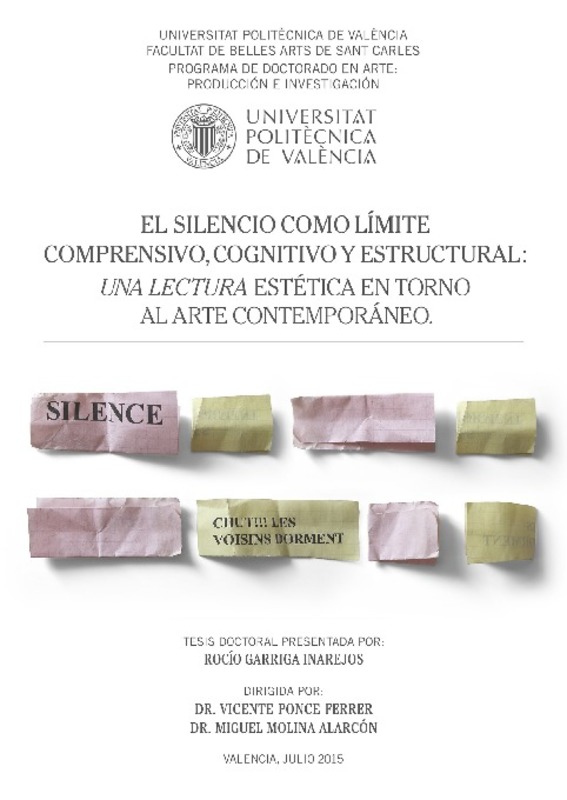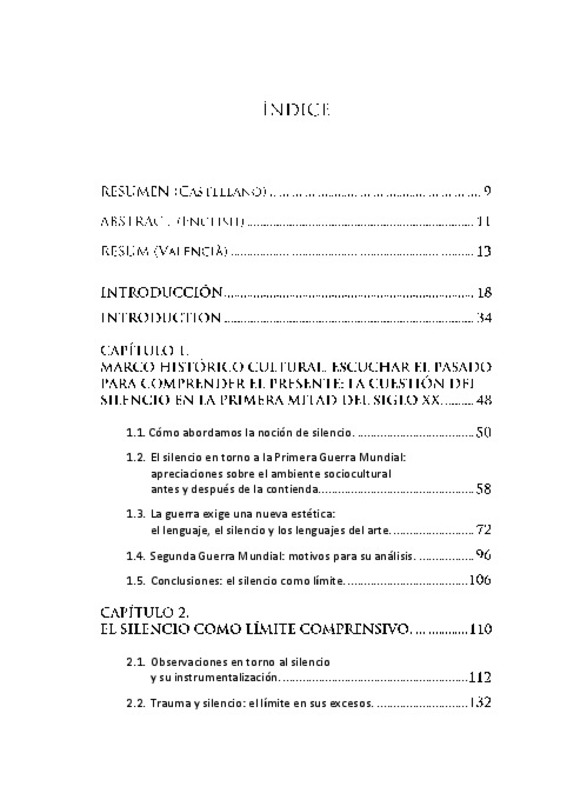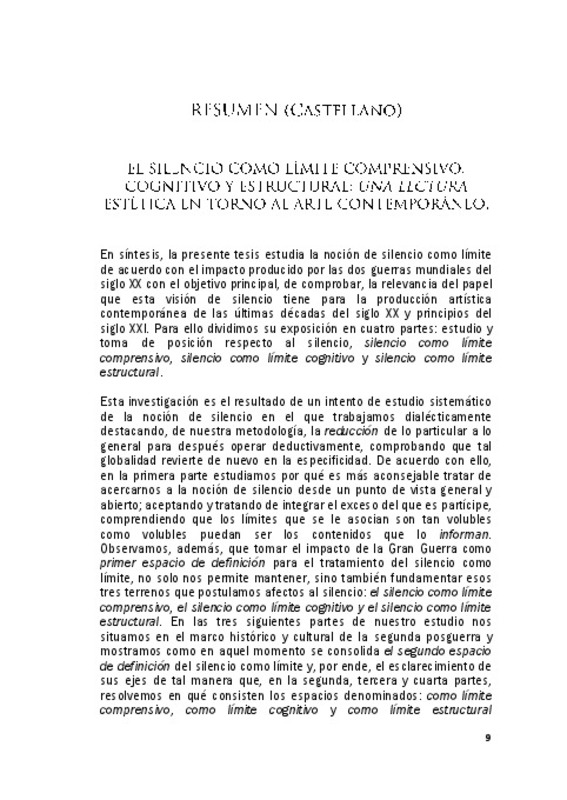|
Resumen:
|
[EN] SILENCE AS UNDERSTANDING, COGNITIVE AND STRUCTURAL LIMIT: AN AESTHETIC READING ON CONTEMPORARY ART.
In short, this thesis studies the concept of silence as limit of agreement after the impact caused by the two World ...[+]
[EN] SILENCE AS UNDERSTANDING, COGNITIVE AND STRUCTURAL LIMIT: AN AESTHETIC READING ON CONTEMPORARY ART.
In short, this thesis studies the concept of silence as limit of agreement after the impact caused by the two World Wars of the 20th century with the main objective of verifying the relevance of the role of this view of silence for the contemporary artistic production of the last decades of the 20th century and beginning of the 21st. In order to reach that objective, we have divided the exposition into four parts: study and taking a stance as concerns silence, silence as understanding limit, silence as cognitive limit and silence as structural limit.
This research is the result of an attempt of systematically studying the notion of silence where we worked dialectically, being the most important aspect of our methodology, the reduction of what is particular to what is general, so as to operate deductively later, checking that such globality goes back again to specificity. According to that, in the first part we have studied why it is more advisable to approach silence from a general, open point of view, accepting and trying to integrate the excess which it is part of, understanding that the limits which are associated to it are as unpredictable as the limits which inform it. Moreover, it is observed that, taking the impact of World War I as a first space of definition for the treatment of silence as limit, not only allows us to keep, but also to lay the foundations of those three fields which we consider linked to silence: as understanding limit, as cognitive limit and as structural limit. In the three following parts of our study we place ourselves inside the historical and cultural frame of the second post-war period, and we show how then the second space of definition of silence as a limit is consolidated, and as a result, the clarification of its core ideas in such a way that, in the second, third and fourth parts, we solve what the so called spaces consist of: silence as understanding limit, silence as cognitive limit and silence as structural limit. Throughout this process we will show some of the artistic manifestations which contribute to their configuration and which later become evident in the context of contemporary art.
As a practical application of this doctoral thesis we are also presenting our own artistic production developed around it in its last sections. With the results obtained, both in the process of investigation and in that of our own associated artistic production, we find that the importance of the concept of silence is undeniable for contemporary artistic productions, and we have located its roots in the display experimented by the concept of silence during the two first thirds of the 20th century.
The implication of the concept of silence is evident in a great variety of languages of the arts and all the stages of the configuration of a plastic work of art: as a creative attitude, as a working topic and as a receptive principle. Something which, on the other hand, we also have the chance to experience by means of our own practice, in the production and exhibition of our artistic work.
[-]
[ES] EL SILENCIO COMO LÍMITE COMPRENSIVO, COGNITIVO Y ESTRUCTURAL: UNA LECTURA ESTÉTICA EN TORNO AL ARTE CONTEMPORÁNEO.
En síntesis, la presente tesis estudia la noción de silencio como límite de acuerdo con el impacto ...[+]
[ES] EL SILENCIO COMO LÍMITE COMPRENSIVO, COGNITIVO Y ESTRUCTURAL: UNA LECTURA ESTÉTICA EN TORNO AL ARTE CONTEMPORÁNEO.
En síntesis, la presente tesis estudia la noción de silencio como límite de acuerdo con el impacto producido por las dos guerras mundiales del siglo XX con el objetivo principal, de comprobar, la relevancia del papel que esta visión de silencio tiene para la producción artística contemporánea de las últimas décadas del siglo XX y principios del XXI. Para ello dividimos su exposición en cuatro partes: estudio y toma de posición respecto al silencio, silencio como límite comprensivo, silencio como límite cognitivo y silencio como límite estructural.
Esta investigación es el resultado de un intento de estudio sistemático de la noción de silencio en el que trabajamos dialécticamente destacando, de nuestra metodología, la reducción de lo particular a lo general para después operar deductivamente, comprobando que tal globalidad revierte de nuevo en la especificidad. De acuerdo con ello, en la primera parte estudiamos por qué es más aconsejable tratar de acercarnos a la noción de silencio desde un punto de vista general y abierto; aceptando y tratando de integrar el exceso del que es partícipe, comprendiendo que los límites que se le asocian son tan volubles como volubles puedan ser los contenidos que lo informan. Observamos, además, que tomar el impacto de la Gran Guerra como primer espacio de definición para el tratamiento del silencio como límite, no solo nos permite mantener, sino también fundamentar esos tres terrenos que postulamos afectos al silencio: el silencio como límite comprensivo, el silencio como límite cognitivo y el silencio como límite estructural. En las tres siguientes partes de nuestro estudio nos situamos en el marco histórico y cultural de la segunda posguerra y mostramos como en aquel momento se consolida el segundo espacio de definición del silencio como límite y, por ende, el esclarecimiento de sus ejes de tal manera que, en la segunda, tercera y cuarta partes, resolvemos en qué consisten los espacios denominados: como límite comprensivo, como límite cognitivo y como límite estructural mostrando, durante tal proceso, algunas de las manifestaciones artísticas que contribuyen a su configuración y que luego se hacen evidentes en el contexto del arte contemporáneo.
Como aplicación práctica de esta tesis doctoral también presentamos la producción artística propia desarrollada al respecto en sus últimos apartados. Con los resultados obtenidos, tanto en el proceso de investigación como en el de nuestra práctica artística ¿que hemos aportado como enfoque teórico-práctico en el que se engloba la noción de silencio en las tres vertientes que presentamos, hallamos que la importancia de la noción de silencio es innegable para la producción artística contemporánea; localizando sus raíces en el despliegue que esta experimenta durante los dos primeros tercios del siglo XX.
La implicación de la noción de silencio es notoria en los más variados lenguajes de las artes y en todos los estadios que atraviesa la configuración de la obra plástica: como actitud creativa, como tema de trabajo y como principio receptivo. Algo que, por otra parte, también tenemos la oportunidad de experimentar, mediante la práctica propia, en la producción y exhibición de nuestro trabajo artístico.
[-]
[CA] EL SILENCI COM A LÍMIT COMPRENSIU, COGNITIU I ESTRUCTURAL: UNA LECTURA ESTÈTICA AL VOLTANT DE L' ART CONTEMPORANI.
En síntesi, la present tesi estudia la noció de silenci com a límit d'acord amb l'impacte provocat ...[+]
[CA] EL SILENCI COM A LÍMIT COMPRENSIU, COGNITIU I ESTRUCTURAL: UNA LECTURA ESTÈTICA AL VOLTANT DE L' ART CONTEMPORANI.
En síntesi, la present tesi estudia la noció de silenci com a límit d'acord amb l'impacte provocat per les dues guerres mundials del segle XX amb l'objectiu principal, de comprovar, la rellevància del paper que aquesta visió de silenci té per a la producció artística contemporània de les últimes dècades del segle XX i principis del XXI. Amb aquesta finalitat dividim la seua exposició en quatre parts: estudi i presa de posició respecte al silenci, silenci com a límit comprensiu, silenci com a límit cognitiu i silenci com a límit estructural.
Aquesta investigació és el resultat d'un intent d'estudi sistemàtic de la noció de silenci en el qual treballem dialècticament fent palesa de la nostra metodologia la reducció d'allò particular a allò general per després operar deductivament, i comprovar que aquesta globalitat reverteix de bell nou en l'especificitat. D'acord amb això, en la primera part estudiem per què és més aconsellable tractar d'acostar-nos a la noció de silenci des d'un punt de vista general i obert, acceptant i tractant d'integrar l'excés de què és partícip, comprenent que els límits que se li associen són tan volubles com volubles puguen ser els continguts que l'informen. S'observa, a més, que prendre l'impacte de la Gran Guerra com a primer espai de definició per al tractament del silenci com a límit, no tan sols ens permet mantenir, sinó també fonamentar eixos tres terrenys que postulem afectes al silenci: el silenci com a límit comprensiu, el silenci com a límit cognitiu i el silenci com a límit estructural. En les tres següents parts del nostre estudi ens situem en el marc històric i cultural de la segona postguerra i mostrem com en aquell moment es consolida el segon espai de definició del silenci com a límit i, consegüentment, l'esclariment dels seus eixos de tal manera que, en la segona, tercera i quarta parts, resolem en què consisteixen els espais denominats: com a límit comprensiu, com a límit cognitiu i com a límit estructural. Tot mostrant durant aquest procés algunes de les manifestacions artístiques que contribueixen a la seua configuració i que després es fan evidents en el context de l'art contemporani.
Com a aplicació pràctica de la present tesi doctoral també presentem la producció artística pròpia desenvolupada en els seus últims apartats. Amb els resultats obtinguts, tant en el procés d'investigació com en el de la nostra pràctica artística associada, trobem que la importància de la noció de silenci és innegable per a la producció artística contemporània tot localitzant els seus arrels en el desplegament que la noció de silenci experimenta durant els dos primers terços del segle XX.
La implicació de la noció de silenci és notòria en els més variats llenguatges de les arts i en tots els estadis que travessa la configuració de l'obra plàstica: com a actitud creativa, com a tema de treball i com a principi receptiu. Quelcom que, per altra banda, també tenim l'oportunitat d'experimentar mitjançant la pràctica pròpia, en la producció i exhibició del nostre treball artístic.
[-]
|












